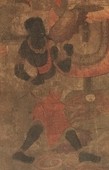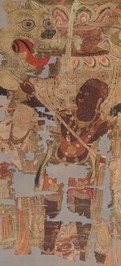 |
 |
 |
 |
 |
 |
 |
 |
 |
 |
 |
 |
 |
 |
 |
 |
 |
 |
 |
 |
 |
 |
 |
 |
 |
 |
 |
 |
 |
 |
 |
|
|
 |
|
|
|
Back to Table of Contents
To next page
At Dunhuang ; Cave 25, Yulin Grottoes (781-847A.D)
----------------------------------
Dunhuang is in the north-western desert of China at the crossroad of important caravan routes.
On the north side of the western wall of the cave is an illustration of Manjusri Bodhisattva. Bodhisattvas are Buddha-designates or higher beings who have temporarily set aside the attainment of nirvana in order to help others find the way, and alleviate suffering. Manjusri personifies wisdom and is shown as eternally young and beautiful. Often he is as here shown riding on a tame lion held by a Kunlun (black person)
|
|
|
|
|
|
 |
|
|
|
|
Note ; it was not only in north west China that this kind of paintings were made ; another example comes from south west China from the Shizhong Mountain Grotto Cluster. In the fourth Grotto (of the Saints), there is the middle Buddha Pilu on the right are Samantabhadra on the elephant and the slaves of Kunlun, and on the left is Manjusri riding on a lion. Also in India is he shown with black people.
|
|
|
|
|
|
 |
|
|
|
|
|
|
Note 2 : On top is given a fragment of The Bodhisattva Manjusri delineated on a palm leaf manuscript, the Ashtasahasrika Prajnaparamita from Bihar east-India. It dates from the 10th-12th century. (Taken from : plantcultures.org.uk). It depicts a black man sitting at the feet of Manjusri. |
|
|
|
|
|
The map of Tang China shows clearly how Chinese influence was growing along the silk road. Dunhuang was the exit point of the old China situated on the Chinese wall. Chang'an was the tang capital where are found statutes of Kunlun slaves. The pictures found of Kunlun slaves at Dunhuang have as much change to represent Indonesians or Africans as the statues. |
|
|
|
|
|
 |
|
|
|
|
Given is a text from Li Fang (980) that has to show that the people drawn were considered by the chinese to be Kunlun slaves. (And not black people from India)
Taiping Kuang Chi (Book CCCXL )
In the tenth moon of the sixth year of the Cheng Yuan Period (A.D. 790), Lu Shu was residing at Ch'ien-t'ang�. He had a maid-servant whose name Hsiao Chin ('Little Golden One') and who was about fifteen years old. . . One night she dreamt of, an old man mounted on a huge lion similar in color to the Lion that bears Manju Sri. The lion's speed was so great as to render it all but invisible when it moved. On either side of the lion were K'un-lun slaves to hold the reins. 'It came to my ears,' the old man said to her, that you were being persecuted by demons. For which
reason I have come hither from a very great distance ���. |
|
|
|
|
|
|
On the chances that they actually depict Africans see: Note on Kunlun |
|
|
|
|
|
 |
|
|
 |
|
|
|
|
|
 |
|
|
|
|
|
|
|
 |
|
|
|
Not only the wall paintings in Dunhuang show Kunlun slaves, the documents found there do too. The once shown are all taken from: Aurel Stein, The Thousand Buddhas. They are all depicted as servants taking care of a lion and occasionally an elephant. |
|
|
|
|
|
|
|
|
|
Dunhuang Cave 463 constructed during the Yuan dynasty: the south wall features a portrait of Manjusri, the top portion shows three disciples, the middle portion a monk, two donors, a lion and a slave. |
|
|
|
|







